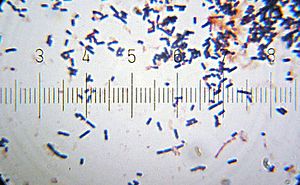Lactobacillus acidophilus/ja: Difference between revisions
Created page with "=== 副作用 === プロバイオティクスは一般的に安全であるが、経口投与で使用する場合、消化管から血流に生菌が移行する(菌血症)リスクがわずかにあり、健康上有害な結果を引き起こす可能性がある。免疫不全免疫系の低下、短腸症候群、中心静脈カテーテル、心臓弁膜症、未熟児などの一部の人々は、有害事象のリス..." Tags: Mobile edit Mobile web edit |
|||
| (14 intermediate revisions by the same user not shown) | |||
| Line 13: | Line 13: | ||
'''''ラクトバチルス・アシドフィルス'''''('''''Lactobacillus acidophilus''''')([[:en:Neo-Latin|新ラテン語]]「酸を好む乳酸菌」)は、1900年に乳児の糞便から初めて分離された、棒状の[[Gram-positive bacteria/ja|グラム陽性菌]]、[[homofermentative/ja|同種発酵]]、[[Anaerobic organism/ja|嫌気性菌]]の微生物である。この種は最も一般的にヒト、特に消化管、口腔、膣、および発酵乳やヨーグルトなどの様々な発酵食品に存在する。この種は低pHレベル(5.0以下)で最も増殖しやすく、至適増殖温度は37℃である。ある種の''L. acidophilus''株は強い[[probiotic/ja|プロバイオティクス]]効果を示し、酪農生産に商業的に利用されている。L.アシドフィルス''のゲノムは解読されている。 | '''''ラクトバチルス・アシドフィルス'''''('''''Lactobacillus acidophilus''''')([[:en:Neo-Latin|新ラテン語]]「酸を好む乳酸菌」)は、1900年に乳児の糞便から初めて分離された、棒状の[[Gram-positive bacteria/ja|グラム陽性菌]]、[[homofermentative/ja|同種発酵]]、[[Anaerobic organism/ja|嫌気性菌]]の微生物である。この種は最も一般的にヒト、特に消化管、口腔、膣、および発酵乳やヨーグルトなどの様々な発酵食品に存在する。この種は低pHレベル(5.0以下)で最も増殖しやすく、至適増殖温度は37℃である。ある種の''L. acidophilus''株は強い[[probiotic/ja|プロバイオティクス]]効果を示し、酪農生産に商業的に利用されている。L.アシドフィルス''のゲノムは解読されている。 | ||
''L.アシドフィルス''は''[[Staphylococcus aureus/ja|黄色ブドウ球菌]]、[[Escherichia coli/ja|大腸菌]]、[[Salmonella typhimurium/ja|サルモネラ・チフス菌]]、''[[Clostridium perfringens/ja|クロストリジウム・ペルフリンゲンス]]''の増殖に対して拮抗作用を示す。この4菌のうち、最も影響を受けるのは''黄色ブドウ球菌''である。黄色ブドウ球菌と並んで、もう1つのグラム陽性菌である''C. perfringens''は、グラム陰性菌である他の2つの菌よりも、''L. アシドフィルス菌''の影響を強く受けた。''L.アシドフィルス''は、''[[Streptococcus mutans/ja|ストレプトコッカス・ミュータンス]]''による口腔プラーク形成も減少させることが判明している。 | |||
''L. | |||
== 歴史{{Anchor|History}}== | |||
== History == | ''ラクトバチルス・アシドフィルス''は、1900年にエルンスト・モロ(Ernst Moro)によってヒトの消化管から初めて分離され、当初の名称は''Bacillus acidophilus''であった。時を経て、生物の分類学的特徴を明らかにする方法には多くの変化があり、1929年に''Lactobacillus''という属分けに至った。1つの分離株から複数の菌株が分離され、様々な名前が付けられると、原菌株を見つけるのが難しくなる。''L.アシドフィルス''に関する研究のほとんどは、''ラクトバチルス・アシドフィルス''NCFMという1つの菌株に焦点を当てたものであった。L.アシドフィルス菌''NCFM''に関する大量の情報が発見されたことで、[[Food and Drug Administration/ja|米国食品医薬品局]]は、この微生物を飲料、乳製品、その他のプロバイオティクス食品の認可成分であると判断した。 | ||
'' | |||
== 生物学的および生化学的特徴{{Anchor|Biological and biochemical features}} == | |||
== Biological and biochemical features == | === 形態学的特徴=== | ||
=== | [[File:Lactobacillus_acidophilus_SEM.jpg|thumb|''乳酸菌''を[[:en:scanning electron microscope|走査型電子顕微鏡]](SEM)で撮影した画像。]] | ||
[[File:Lactobacillus_acidophilus_SEM.jpg|thumb|'' | [[File:Lactobacillus acidophilus (259 08) Lactobacillus acidophilus (Döderlein bacillus).jpg|thumb|''ラクトバチルス・アシドフィルス''の培養液]] | ||
[[File:Lactobacillus acidophilus (259 08) Lactobacillus acidophilus (Döderlein bacillus).jpg|thumb| | ''ラクトバチルス・アシドフィルス''は、大きさが2-10μmである、動かない棒状の(桿菌)グラム陽性生物である。''アシドフィルス''は[[Lipid bilayer/ja|リン脂質二重層膜]]を持ち、膜の外側には[[peptidoglycan/ja|ペプチドグリカン]]からなる大きな細胞壁がある。''L.アシドフィルス''の細胞壁は[[teichoic acid/ja|テイコ酸]]と表面タンパク質が織り成すもので、陰イオン性多糖類と中性多糖類、そして細胞の外側を覆うS層がある。''L.アシドフィルス菌''のS層タンパク質は、粘液や他の細胞外タンパク質だけでなく、上皮細胞にも接着することが示されている。S-層は2つの構造ドメインからできている。C末端ドメインは細胞壁の固定を担い、N末端ドメインは細胞環境との相互作用とS層の自己形成を担っている。''L.アシドフィルス''属では、N-末端領域はアミノ酸変異が大きく、配列相同性も低い(31-72%)。''L.アシドフィルス菌''は、鞭毛やピルのような細胞外運動手段を持たないため、動かない微生物である。 | ||
'' | [[File:Lactobacillus acidophilus (259 09) Lactobacillus acidophilus (Döderlein bacillus).jpg|thumb|''ラクトバチルス・アシドフィルス''顕微鏡下、背景は暗い。]] | ||
[[File:Lactobacillus acidophilus (259 09) Lactobacillus acidophilus (Döderlein bacillus).jpg|thumb|'' | |||
=== 代謝=== | |||
[[File:Lactic acid fermentation.png|thumb|エネルギー生産の手段としてグルコースが乳酸に変換される経路]] | |||
[[File:Lactic acid fermentation.png|thumb| | ''アシドフィルス''はホモ発酵性嫌気性微生物であり、発酵の最終産物として乳酸のみを産生する。また、[[Glycolysis/ja|EMP経路]](解糖系)によりヘキソース(ペントースではない)のみを発酵させることができる。''L.アシドフィルス''は、利用可能な栄養素が限られているため、宿主の中にいるときよりも牛乳の中で成長する時間が遅い。牛乳中のプロバイオティクスとして使用されているため、アメリカの''Journal of Dairy Science''が行った研究では、''L. アシドフィルス''の低い増殖速度を上げるために必要な栄養素を調べた。この研究では、[[glucose/ja|グルコース]]とアミノ酸[[cysteine/ja|システイン]]、[[glutamic acid/ja|グルタミン酸]]、[[isoleucine/ja|イソロイシン]]、[[leucine/ja|ロイシン]]、[[lysine/ja|リジン]]、[[methionine/ja|メチオニン]]、[[methionine/ja|フェニルアラニン]]、[[threonine/ja|スレオニン]]、[[tyrosine/ja|チロシン]]、[[valine/ja|バリン]]、[[arginine/ja|アルギニン]]が''L. アシドフィルス''の増殖に必須な栄養素であることがわかった。[[glycine/ja|グリシン]]、パントテン酸カルシウム、Mn<sup>2+</sup>は刺激性栄養素として作用する。この研究は、牛乳中の''アシドフィルス菌''の増殖率が低いことを説明するのに役立つ。消費率の高いアミノ酸を発酵乳に加えることは、この問題の解決策になりうる。 | ||
'' | |||
=== ゲノム科学 === | |||
[[Prokaryote/ja|原核生物]]のゲノムの特殊性は、[[Cell replication/ja|複製]]の際に原核生物がどのように[[DNA/ja|DNA]]を複製するかを認識することで区別できる。''L.アシドフィルス''では、複製は[[Origin of replication/ja|oriC]]と呼ばれる起点から始まり、[[DNA replication/ja|複製フォーク]]の形で双方向に移動する。DNAは[[DNA replication/ja|先導鎖]]上では連続的に、[[DNA replication/ja|遅行鎖]]上では不連続な[[Okazaki fragments/ja|岡崎フラグメント]]として、[[DNA polymerase III holoenzyme/ja||DNAポリメラーゼIII]]酵素の助けを借りて合成される。先行鎖と遅行鎖のDNA合成を開始するには、RNAプライマーが必要である。DNAポリメラーゼIIIは、RNAプライマーに従って5'から3'方向にDNAを合成する。''L.アシドフィルス菌''の[[genome/ja|ゲノム]]は小さく、[[GC-content/ja|グアニン-シトシン]]含量は約30%と低い。様々な''L. アシドフィルス''の46株のゲノムを比較した研究によると、ゲノムのサイズは1.95Mbから2.09Mbで、平均サイズは1.98Mbであった。ゲノム中の平均コード配列数は1780個で、発酵食品や市販のプロバイオティクスから分離された株は、ヒトから分離された株よりも平均してコード配列数が多かった。''L.アシドフィルス''はオープンな状態の[[pan-genome/ja|パンゲノム]](種内の全遺伝子)を持っており、シーケンシングされたゲノムの数が増えるにつれてパンゲノムのサイズが大きくなることを意味している。コアゲノム(種の全個体が共有する遺伝子)は、''L. アシドフィルス''の場合、約1117遺伝子で構成されている。 遺伝子解析の結果、すべての''L. アシドフィルス''株が、糖質代謝の主要酵素であるグリコシルヒドロラーゼの少なくとも15ファミリーを含んでいることも明らかになった。15のGHファミリーはそれぞれ、グルコース、ガラクトース、フルクトース、スクロース、デンプン、マルトースなどの一般的な炭水化物の代謝に関与していた。抗生物質の排出、抗生物質の標的変更、および抗生物質の標的防御による抗生物質耐性をコードする遺伝子は、すべての''L. アシドフィルス''株に存在し、すべての株で18種類の抗生物質に対する防御を提供していた。フルオロキノロン系、グリコペプチド系、リンコサミド系、マクロライド系、テトラサイクリン系は、''L. アシドフィルス''が最も高い耐性を示した5つの抗生物質クラスであり、これらのクラスに関連する300以上の遺伝子が存在した。 | |||
== 環境{{Anchor|Environment}}== | |||
== Environment == | [[File:Epithelial Tissues Simple Columnar Epithelium (41006485014).jpg|thumb|哺乳類の腸管から採取した柱状上皮細胞。''L.アシドフィルス菌''はこの細胞型に付着しやすく、よく増殖する。]] | ||
[[File:Epithelial Tissues Simple Columnar Epithelium (41006485014).jpg|thumb| | ''L.アシドフィルス菌''は、哺乳類の口腔、腸、膣腔で自然に増殖する。ほぼ全ての乳酸菌種は、[[Chaperone (protein)/ja|シャペロン]]の活性を高めることを含む耐熱性のための特別なメカニズムを持っている。シャペロンは高度に保存されたストレスタンパク質であり、高温に対する抵抗性の強化、リボソームの安定性、温度感知、高温でのリボソーム機能の制御を可能にする。この高温で機能する能力は、発酵過程における細胞の収量にとって極めて重要であり、現在、''L. アシドフィルス''の温度耐性を高めるための[[genetic testing/ja|遺伝子検査]]が行われている。プロバイオティクスとして考える場合、''L. アシドフィルス''が消化管での生活に適した形質を持つことが重要である。低いpHや高い毒性レベルに対する耐性がしばしば要求される。これらの形質は様々であり、菌株特異的である。これらの耐性が発現されるメカニズムには、細胞壁構造の違いや、その他のタンパク質発現の変化が含まれる。塩濃度の変化は''L. アシドフィルス''の生存率に影響を与えることが示されているが、それはより高い塩濃度にさらされた後のみである。米国酪農科学協会が注目した別の実験では、生存細胞数は7.5%以上の濃度のNaClに暴露した後にのみ有意な減少を示した。また、NaCl濃度10%以上の条件下で培養した場合、細胞は明らかに伸長することが観察された。''L.アシドフィルス''は乳製品培地での生育にも非常に適しており、発酵乳は''L.アシドフィルス''を腸内細菌叢に導入する理想的な送達方法である。噴霧乾燥技術によってカプセル化された''L. アシドフィルス''細胞の冷蔵保存(4 °C)の生存率は、室温保存(25 °C)の生存率よりも高い。 | ||
''L. | |||
=== クォーラムセンシング === | |||
= | 細胞間の[[Quorum sensing/ja|クォーラムセンシング]]は、細胞シグナル伝達が協調的な活動につながり、最終的に細菌が遺伝子発現を連続的に制御するのに役立つプロセスである。これは、細胞数の増加に反応して分泌される小さな[[autoinducer/ja|自己誘導物質]]の検出によって達成される。消化管に生息する''ラクトバチルス・アシドフィルス''では、[[biofilm/ja|バイオフィルム]]形成や毒素分泌を考慮すると、クオラムセンシングは細菌間の相互作用に重要である。''L.アシドフィルス菌''では、他の多くの細菌とともに、''luxS''を介したクオラムセンシングが行動の制御に関与している。単培養では、''[[luxS/ja|luxS]]''の産生は指数関数的増殖期に増加し、定常期に進むにつれてプラトーになる。L.アシドフィルス''を他の''ラクトバチルス''種と共培養すると、''luxS''のアップレギュレーションが起こりうる。 | ||
[[Quorum sensing]] | |||
=== 膣内細菌叢=== | |||
''ラクトバチルス・アシドフィルス''は、''[[Lactobacillus crispatus/ja|ラクトバチルス・クリスパタス]]''、''[[Lactobacillus gasseri/ja|ラクトバチルス・ガッセリ]]''、''[[Lactobacillus jensenii/ja|ラクトバチルス・ジェンセニ]]''、および''[[Lactobacillus iners/ja|ラクトバチルス・イナース]]''を含む同属の他の種とともに[[List of microbiota species of the lower reproductive tract of women/ja|膣微生物叢]]の一部である。 | |||
'' | 実験では、''L. アシドフィルス''は''[[Candida albicans/ja|カンジダ・アルビカンス]]''が膣上皮細胞に付着する能力を低下させるようであった。しかし、'''L. アシドフィルス'''のイースト感染予防における役割は、この種の'''乳酸菌'''は膣細胞に付着する(それによってコロニー形成する)能力があまり強くないことも判明しているため、不明である。 | ||
== 治療利用{{Anchor|Therapeutic uses}} == | |||
== Therapeutic uses == | [[File:Vaginal capsule 2.jpg|thumb|膣の健康に使用される''L. アシドフィルス菌''を含むカプセル]] | ||
[[File:Vaginal capsule 2.jpg|thumb| | ''L.アシドフィルス菌''の存在は、病原体に対するバリアーとして働き、乳糖消化を助け、免疫反応を高め、コレステロール値を下げるなど、ヒトに様々なプロバイオティクス効果をもたらすことが研究で示されている。''L.アシドフィルス''がこれらの効果を発揮するには、1mLあたり10^5~10^6c.f.u(コロニー形成単位)の濃度で存在する必要がある。[[:en:Wake Forest School of Medicine|ウェイクフォレスト医科大学]]で行われた研究では、''アシドフィルス菌''がマウスの腸内細菌叢の構造と組成に及ぼす影響を、マウスの年齢別に調べた。この研究では、腸内微生物環境内の微生物間の相互作用が生物全体の健康に重要であることが立証され、''L. アシドフィルス菌''を補充したマウスは、同程度の年齢の他のマウスと比較して、プロテオバクテリアのレベルが減少し、他のプロバイオティクス細菌のレベルが増加したことが示された。マラナタ・クリスチャン大学で行われた別の研究では、''L. アシドフィルス''無細胞上清(微生物の増殖によって生成された代謝物を含む液体培地)が、腸チフスの原因菌である''サルモネラ・チフィ''の増殖パターンに与える影響について研究された。この研究は、''L. acidophilus''の代謝産物の存在が、''S. typhi''が示す増殖曲線を有意に抑制することを示し、''L. アシドフィルス''の存在が腸内微生物群集の種構成に良い影響を与え、生物に腸の健康上の利益をもたらすという考えを支持した。アシドフィルス菌の自然免疫系は抗菌ペプチドも産生する。そこで発見された一群の短いペプチドは、ウイルスや、がん細胞を含む他の細胞タイプに対する強さなど、抗菌特性を示している。血液透析を受けた患者の胃腸症状の治療に、共生ゲル(''L. アシドフィルス''を含む)の使用を支持する証拠もいくつかある。このゲルはまた、嘔吐、胸やけ、腹痛の発生を減少させた。確固たる結論を出すためには、このテーマに関するさらなる研究が必要である。 | ||
=== 乳業での利用 === | |||
[[File:Katugen 002.jpg|thumb|発酵乳の一例。''L. acidophilus''は、プロバイオティクス効果を期待して一般的に添加される]] | |||
[[File:Katugen 002.jpg|thumb| | 米国酪農科学協会の雑誌に記載されているように、『ラクトバチルス・アシドフィルス』は、高品質の発酵製品を得るために酪農業界で広く使用されている市販の菌株であり、プロバイオティクスである」。''L.アシドフィルス''株を含む発酵乳の摂取による腸内の有益菌レベルの増加、病原性菌レベルの減少には、様々なプロバイオティクス効果がある。血清コレステロール値の低下、免疫反応の促進、乳酸消化の改善などはすべて、腸内の''L.アシドフィルス''の存在に関連したプロバイオティック効果である。''L.アシドフィルス''は、唾液中の''ストレプトコッカス・ミュータンス''レベルを低下させ、非アルコール性脂肪性肝疾患の発症に関連する危険因子を減少させる効果もあった。最も広く研究され、抗生物質として最も広く使用されている''L. アシドフィルス''の菌株は、NCFMと呼ばれている。 | ||
=== 副作用 === | |||
プロバイオティクスは一般的に安全であるが、経口投与で使用する場合、消化管から血流に生菌が移行する([[bacteremia/ja|菌血症]])リスクがわずかにあり、健康上有害な結果を引き起こす可能性がある。免疫不全[[Immunocompromised/ja|免疫系の低下]]、短腸症候群、中心静脈カテーテル、心臓弁膜症、未熟児などの一部の人々は、有害事象のリスクが高い可能性がある。 | |||
== こちらも参照 == | |||
* [[Lactic acid fermentation/ja]] | |||
* [[Lactic acid fermentation]] | |||
== 外部リンク == | |||
{{Commons category|Lactobacillus acidophilus}} | {{Commons category|Lactobacillus acidophilus}} | ||
* [https://www.nlm.nih.gov/medlineplus/druginfo/natural/790.html ''Lactobacillus''] at MedlinePlus | * [https://www.nlm.nih.gov/medlineplus/druginfo/natural/790.html ''Lactobacillus''] at MedlinePlus | ||
| Line 93: | Line 68: | ||
* [http://bacdive.dsmz.de/index.php?search=6404&submit=Search Type strain of ''Lactobacillus acidophilus'' at Bac''Dive'' – the Bacterial Diversity Metadatabase] | * [http://bacdive.dsmz.de/index.php?search=6404&submit=Search Type strain of ''Lactobacillus acidophilus'' at Bac''Dive'' – the Bacterial Diversity Metadatabase] | ||
* [https://pocketreviewer.com/lactobacillus-acidophilus ''Lactobacillus acidophilus - Benefits & Probiotic Uses''] at Pocket Reviewer | * [https://pocketreviewer.com/lactobacillus-acidophilus ''Lactobacillus acidophilus - Benefits & Probiotic Uses''] at Pocket Reviewer | ||
{{Taxonbar|from=Q22060}} | {{Taxonbar|from=Q22060}} | ||
[[Category:Probiotics]] | [[Category:Probiotics]] | ||
[[Category:Lactobacillaceae]] | [[Category:Lactobacillaceae]] | ||
| Line 106: | Line 76: | ||
[[Category:Bacteria used in dairy products]] | [[Category:Bacteria used in dairy products]] | ||
[[Category:Gram-positive bacteria]] | [[Category:Gram-positive bacteria]] | ||
Latest revision as of 08:34, 17 April 2024
| Lactobacillus acidophilus/ja | |
|---|---|

| |
| "ラクトバチルス・アシドフィルス", 数字の目盛りは11 μm | |
| Scientific classification | |
| Domain: | Bacteria |
| Phylum: | Bacillota |
| Class: | Bacilli |
| Order: | Lactobacillales |
| Family: | Lactobacillaceae |
| Genus: | Lactobacillus |
| Species: | acidophilus
|
| Binomial name | |
| acidophilus | |
ラクトバチルス・アシドフィルス(Lactobacillus acidophilus)(新ラテン語「酸を好む乳酸菌」)は、1900年に乳児の糞便から初めて分離された、棒状のグラム陽性菌、同種発酵、嫌気性菌の微生物である。この種は最も一般的にヒト、特に消化管、口腔、膣、および発酵乳やヨーグルトなどの様々な発酵食品に存在する。この種は低pHレベル(5.0以下)で最も増殖しやすく、至適増殖温度は37℃である。ある種のL. acidophilus株は強いプロバイオティクス効果を示し、酪農生産に商業的に利用されている。L.アシドフィルスのゲノムは解読されている。
L.アシドフィルスは黄色ブドウ球菌、大腸菌、サルモネラ・チフス菌、クロストリジウム・ペルフリンゲンスの増殖に対して拮抗作用を示す。この4菌のうち、最も影響を受けるのは黄色ブドウ球菌である。黄色ブドウ球菌と並んで、もう1つのグラム陽性菌であるC. perfringensは、グラム陰性菌である他の2つの菌よりも、L. アシドフィルス菌の影響を強く受けた。L.アシドフィルスは、ストレプトコッカス・ミュータンスによる口腔プラーク形成も減少させることが判明している。
歴史
ラクトバチルス・アシドフィルスは、1900年にエルンスト・モロ(Ernst Moro)によってヒトの消化管から初めて分離され、当初の名称はBacillus acidophilusであった。時を経て、生物の分類学的特徴を明らかにする方法には多くの変化があり、1929年にLactobacillusという属分けに至った。1つの分離株から複数の菌株が分離され、様々な名前が付けられると、原菌株を見つけるのが難しくなる。L.アシドフィルスに関する研究のほとんどは、ラクトバチルス・アシドフィルスNCFMという1つの菌株に焦点を当てたものであった。L.アシドフィルス菌NCFMに関する大量の情報が発見されたことで、米国食品医薬品局は、この微生物を飲料、乳製品、その他のプロバイオティクス食品の認可成分であると判断した。
生物学的および生化学的特徴
形態学的特徴


ラクトバチルス・アシドフィルスは、大きさが2-10μmである、動かない棒状の(桿菌)グラム陽性生物である。アシドフィルスはリン脂質二重層膜を持ち、膜の外側にはペプチドグリカンからなる大きな細胞壁がある。L.アシドフィルスの細胞壁はテイコ酸と表面タンパク質が織り成すもので、陰イオン性多糖類と中性多糖類、そして細胞の外側を覆うS層がある。L.アシドフィルス菌のS層タンパク質は、粘液や他の細胞外タンパク質だけでなく、上皮細胞にも接着することが示されている。S-層は2つの構造ドメインからできている。C末端ドメインは細胞壁の固定を担い、N末端ドメインは細胞環境との相互作用とS層の自己形成を担っている。L.アシドフィルス属では、N-末端領域はアミノ酸変異が大きく、配列相同性も低い(31-72%)。L.アシドフィルス菌は、鞭毛やピルのような細胞外運動手段を持たないため、動かない微生物である。

代謝

アシドフィルスはホモ発酵性嫌気性微生物であり、発酵の最終産物として乳酸のみを産生する。また、EMP経路(解糖系)によりヘキソース(ペントースではない)のみを発酵させることができる。L.アシドフィルスは、利用可能な栄養素が限られているため、宿主の中にいるときよりも牛乳の中で成長する時間が遅い。牛乳中のプロバイオティクスとして使用されているため、アメリカのJournal of Dairy Scienceが行った研究では、L. アシドフィルスの低い増殖速度を上げるために必要な栄養素を調べた。この研究では、グルコースとアミノ酸システイン、グルタミン酸、イソロイシン、ロイシン、リジン、メチオニン、フェニルアラニン、スレオニン、チロシン、バリン、アルギニンがL. アシドフィルスの増殖に必須な栄養素であることがわかった。グリシン、パントテン酸カルシウム、Mn2+は刺激性栄養素として作用する。この研究は、牛乳中のアシドフィルス菌の増殖率が低いことを説明するのに役立つ。消費率の高いアミノ酸を発酵乳に加えることは、この問題の解決策になりうる。
ゲノム科学
原核生物のゲノムの特殊性は、複製の際に原核生物がどのようにDNAを複製するかを認識することで区別できる。L.アシドフィルスでは、複製はoriCと呼ばれる起点から始まり、複製フォークの形で双方向に移動する。DNAは先導鎖上では連続的に、遅行鎖上では不連続な岡崎フラグメントとして、|DNAポリメラーゼIII酵素の助けを借りて合成される。先行鎖と遅行鎖のDNA合成を開始するには、RNAプライマーが必要である。DNAポリメラーゼIIIは、RNAプライマーに従って5'から3'方向にDNAを合成する。L.アシドフィルス菌のゲノムは小さく、グアニン-シトシン含量は約30%と低い。様々なL. アシドフィルスの46株のゲノムを比較した研究によると、ゲノムのサイズは1.95Mbから2.09Mbで、平均サイズは1.98Mbであった。ゲノム中の平均コード配列数は1780個で、発酵食品や市販のプロバイオティクスから分離された株は、ヒトから分離された株よりも平均してコード配列数が多かった。L.アシドフィルスはオープンな状態のパンゲノム(種内の全遺伝子)を持っており、シーケンシングされたゲノムの数が増えるにつれてパンゲノムのサイズが大きくなることを意味している。コアゲノム(種の全個体が共有する遺伝子)は、L. アシドフィルスの場合、約1117遺伝子で構成されている。 遺伝子解析の結果、すべてのL. アシドフィルス株が、糖質代謝の主要酵素であるグリコシルヒドロラーゼの少なくとも15ファミリーを含んでいることも明らかになった。15のGHファミリーはそれぞれ、グルコース、ガラクトース、フルクトース、スクロース、デンプン、マルトースなどの一般的な炭水化物の代謝に関与していた。抗生物質の排出、抗生物質の標的変更、および抗生物質の標的防御による抗生物質耐性をコードする遺伝子は、すべてのL. アシドフィルス株に存在し、すべての株で18種類の抗生物質に対する防御を提供していた。フルオロキノロン系、グリコペプチド系、リンコサミド系、マクロライド系、テトラサイクリン系は、L. アシドフィルスが最も高い耐性を示した5つの抗生物質クラスであり、これらのクラスに関連する300以上の遺伝子が存在した。
環境

L.アシドフィルス菌は、哺乳類の口腔、腸、膣腔で自然に増殖する。ほぼ全ての乳酸菌種は、シャペロンの活性を高めることを含む耐熱性のための特別なメカニズムを持っている。シャペロンは高度に保存されたストレスタンパク質であり、高温に対する抵抗性の強化、リボソームの安定性、温度感知、高温でのリボソーム機能の制御を可能にする。この高温で機能する能力は、発酵過程における細胞の収量にとって極めて重要であり、現在、L. アシドフィルスの温度耐性を高めるための遺伝子検査が行われている。プロバイオティクスとして考える場合、L. アシドフィルスが消化管での生活に適した形質を持つことが重要である。低いpHや高い毒性レベルに対する耐性がしばしば要求される。これらの形質は様々であり、菌株特異的である。これらの耐性が発現されるメカニズムには、細胞壁構造の違いや、その他のタンパク質発現の変化が含まれる。塩濃度の変化はL. アシドフィルスの生存率に影響を与えることが示されているが、それはより高い塩濃度にさらされた後のみである。米国酪農科学協会が注目した別の実験では、生存細胞数は7.5%以上の濃度のNaClに暴露した後にのみ有意な減少を示した。また、NaCl濃度10%以上の条件下で培養した場合、細胞は明らかに伸長することが観察された。L.アシドフィルスは乳製品培地での生育にも非常に適しており、発酵乳はL.アシドフィルスを腸内細菌叢に導入する理想的な送達方法である。噴霧乾燥技術によってカプセル化されたL. アシドフィルス細胞の冷蔵保存(4 °C)の生存率は、室温保存(25 °C)の生存率よりも高い。
クォーラムセンシング
細胞間のクォーラムセンシングは、細胞シグナル伝達が協調的な活動につながり、最終的に細菌が遺伝子発現を連続的に制御するのに役立つプロセスである。これは、細胞数の増加に反応して分泌される小さな自己誘導物質の検出によって達成される。消化管に生息するラクトバチルス・アシドフィルスでは、バイオフィルム形成や毒素分泌を考慮すると、クオラムセンシングは細菌間の相互作用に重要である。L.アシドフィルス菌では、他の多くの細菌とともに、luxSを介したクオラムセンシングが行動の制御に関与している。単培養では、luxSの産生は指数関数的増殖期に増加し、定常期に進むにつれてプラトーになる。L.アシドフィルスを他のラクトバチルス種と共培養すると、luxSのアップレギュレーションが起こりうる。
膣内細菌叢
ラクトバチルス・アシドフィルスは、ラクトバチルス・クリスパタス、ラクトバチルス・ガッセリ、ラクトバチルス・ジェンセニ、およびラクトバチルス・イナースを含む同属の他の種とともに膣微生物叢の一部である。 実験では、L. アシドフィルスはカンジダ・アルビカンスが膣上皮細胞に付着する能力を低下させるようであった。しかし、L. アシドフィルスのイースト感染予防における役割は、この種の乳酸菌は膣細胞に付着する(それによってコロニー形成する)能力があまり強くないことも判明しているため、不明である。
治療利用

L.アシドフィルス菌の存在は、病原体に対するバリアーとして働き、乳糖消化を助け、免疫反応を高め、コレステロール値を下げるなど、ヒトに様々なプロバイオティクス効果をもたらすことが研究で示されている。L.アシドフィルスがこれらの効果を発揮するには、1mLあたり10^5~10^6c.f.u(コロニー形成単位)の濃度で存在する必要がある。ウェイクフォレスト医科大学で行われた研究では、アシドフィルス菌がマウスの腸内細菌叢の構造と組成に及ぼす影響を、マウスの年齢別に調べた。この研究では、腸内微生物環境内の微生物間の相互作用が生物全体の健康に重要であることが立証され、L. アシドフィルス菌を補充したマウスは、同程度の年齢の他のマウスと比較して、プロテオバクテリアのレベルが減少し、他のプロバイオティクス細菌のレベルが増加したことが示された。マラナタ・クリスチャン大学で行われた別の研究では、L. アシドフィルス無細胞上清(微生物の増殖によって生成された代謝物を含む液体培地)が、腸チフスの原因菌であるサルモネラ・チフィの増殖パターンに与える影響について研究された。この研究は、L. acidophilusの代謝産物の存在が、S. typhiが示す増殖曲線を有意に抑制することを示し、L. アシドフィルスの存在が腸内微生物群集の種構成に良い影響を与え、生物に腸の健康上の利益をもたらすという考えを支持した。アシドフィルス菌の自然免疫系は抗菌ペプチドも産生する。そこで発見された一群の短いペプチドは、ウイルスや、がん細胞を含む他の細胞タイプに対する強さなど、抗菌特性を示している。血液透析を受けた患者の胃腸症状の治療に、共生ゲル(L. アシドフィルスを含む)の使用を支持する証拠もいくつかある。このゲルはまた、嘔吐、胸やけ、腹痛の発生を減少させた。確固たる結論を出すためには、このテーマに関するさらなる研究が必要である。
乳業での利用

米国酪農科学協会の雑誌に記載されているように、『ラクトバチルス・アシドフィルス』は、高品質の発酵製品を得るために酪農業界で広く使用されている市販の菌株であり、プロバイオティクスである」。L.アシドフィルス株を含む発酵乳の摂取による腸内の有益菌レベルの増加、病原性菌レベルの減少には、様々なプロバイオティクス効果がある。血清コレステロール値の低下、免疫反応の促進、乳酸消化の改善などはすべて、腸内のL.アシドフィルスの存在に関連したプロバイオティック効果である。L.アシドフィルスは、唾液中のストレプトコッカス・ミュータンスレベルを低下させ、非アルコール性脂肪性肝疾患の発症に関連する危険因子を減少させる効果もあった。最も広く研究され、抗生物質として最も広く使用されているL. アシドフィルスの菌株は、NCFMと呼ばれている。
副作用
プロバイオティクスは一般的に安全であるが、経口投与で使用する場合、消化管から血流に生菌が移行する(菌血症)リスクがわずかにあり、健康上有害な結果を引き起こす可能性がある。免疫不全免疫系の低下、短腸症候群、中心静脈カテーテル、心臓弁膜症、未熟児などの一部の人々は、有害事象のリスクが高い可能性がある。
こちらも参照
外部リンク
- Lactobacillus at MedlinePlus
- Lactobacillus acidophilus at University of Maryland Medical Center
- Lactobacillus acidophilus from the U. of Wisconsin
- Global analysis of carbohydrate utilization by Lactobacillus acidophilus using cDNA microarrays
- Safety and protective effect of Lactobacillus acidophilus and Lactobacillus casei used as probiotic agent in vivo
- Pictures and research on Lactobacillus acidophilus Archived 2017-07-01 at the Wayback Machine
- Type strain of Lactobacillus acidophilus at BacDive – the Bacterial Diversity Metadatabase
- Lactobacillus acidophilus - Benefits & Probiotic Uses at Pocket Reviewer